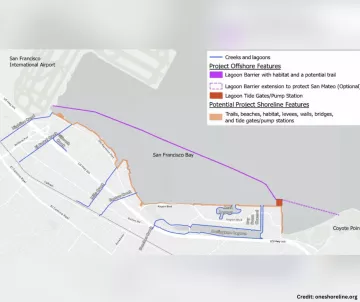
What is Happening
San Mateo County’s Flood and Sea Level Rise Resiliency District, known as OneShoreline, was formed in 2019 to address sea level rise, flooding, coastal erosion, and regional stormwater infrastructure throughout San Mateo County. OneShoreline’s work often spans multiple jurisdictions and involves a variety of public and private stakeholders.
OneShoreline recently came forward with a drastic flood protection plan for Burlingame and Millbrae that entails building a 2.7 to 3.3 mile long offshore barrier, creating a vast lagoon that extends from the San Francisco Airport to the northern edge of San Mateo. Three existing creeks would flow into the lagoon area. The plan calls for building the structure in the Bay, in defiance of a 50-year-old state law forbidding such encroachments to preserve and restore Bay Ecology. The barrier would include tide gates that could maintain some tidal flows into the lagoon when open, or hold back the tides when closed. As sea level rises, the gates will be closed more frequently and eventually closed at all times.
Why It Matters
The construction of a massive off-shore sea wall would not only run counter to a longstanding state policy to prevent building in the Bay, it would also set a dangerous and costly precedent of prematurely sacrificing our essential living shorelines in favor of fortified flood protection infrastructure with little to no flexibility to adapt over time as sea level rise worsens. Rather than pursuing adaptive resilience pathways, starting with nature based adaptation at the shoreline, and adjusting over time as needed, OneShoreline’s approach would jump ahead to the most costly, inflexible, and hardened solution first, in order to facilitate more commercial development in the current shoreline flood zone.
The project also raises substantial water quality concerns. Our Bay is facing an increasing threat from Harmful Algal Blooms (HABs). The offshore barrier and lagoon may replicate the calm, shallow, warmer water conditions susceptible to HABs that could lead to the periodic die-offs of fish, sharks and rays. Furthermore, the disruption (and eventual elimination) of tidal flows into and out of the lagoon and the detention of freshwater flows from creeks will have significant and adverse impacts to water quality within the lagoon. Without a regular cycle of tidal flows, the saline balance within the lagoon will be altered, impacting countless organisms. In addition, polluted stormwater run-off that travels from the creeks to the Bay will no longer be reliably diluted by mixing with massive Bay waters or filtered by shoreline ecosystems. Instead, pollutants (as well as trash) will concentrate in the lagoon, posing threat to wildlife and vegetation and potentially impacting species such as the endangered Ridgeway’s Rail currently identified within the project area.
Unfortunately, the project chosen by OneShoreline came about in a key stakeholder vacuum. No presentations on the project were given to the City Councils of Millbrae or Burlingame prior to OneShoreline’s instigation of formal environmental review under the California Environmental Quality Act (CEQA). Other key stakeholders, such as the San Francisco International Airport, environmental, and recreational groups were not consulted. Underlying documentation of the project and feasibility analyses were not made available to the public until the day before the deadline for public comments and months later, comments received have yet to be published.
Bay Alive Goals
- Improve transparency and reevaluate preferred project alternative informed by input from regulatory and resource agencies, the OneShoreline Board of Directors, key stakeholders, and the community.
- Analyze and consider a variety of adaptation pathways, including nature-based solutions, that can be implemented over time to sustain the shoreline ecology while also protecting communities from flood impacts.
- Ensure that proposed sea level rise projects will not negatively impact water quality and biodiversity.
Links
- OneShoreline’s Millbrae and Burlingame Shoreline Protection and Enhancement Project page
- 11/30/23 Joint Comment Letter on Notice of Preparation of an Environmental Impact Report for the Millbrae and Burlingame Shoreline Area Enhancement Project
- 11/29/23 Bay Alive Scoping Letter on Notice of Preparation of an Environmental Impact Report for the Millbrae and Burlingame Shoreline Area Enhancement Project